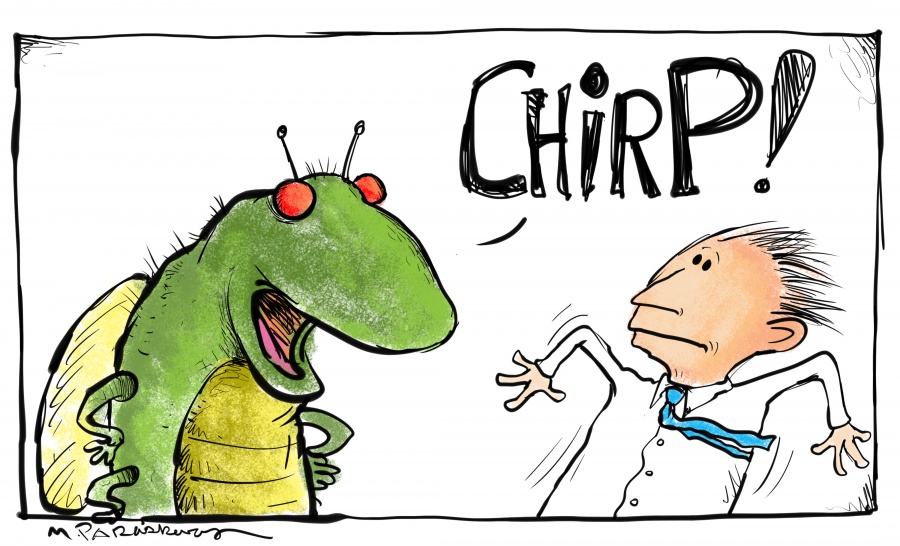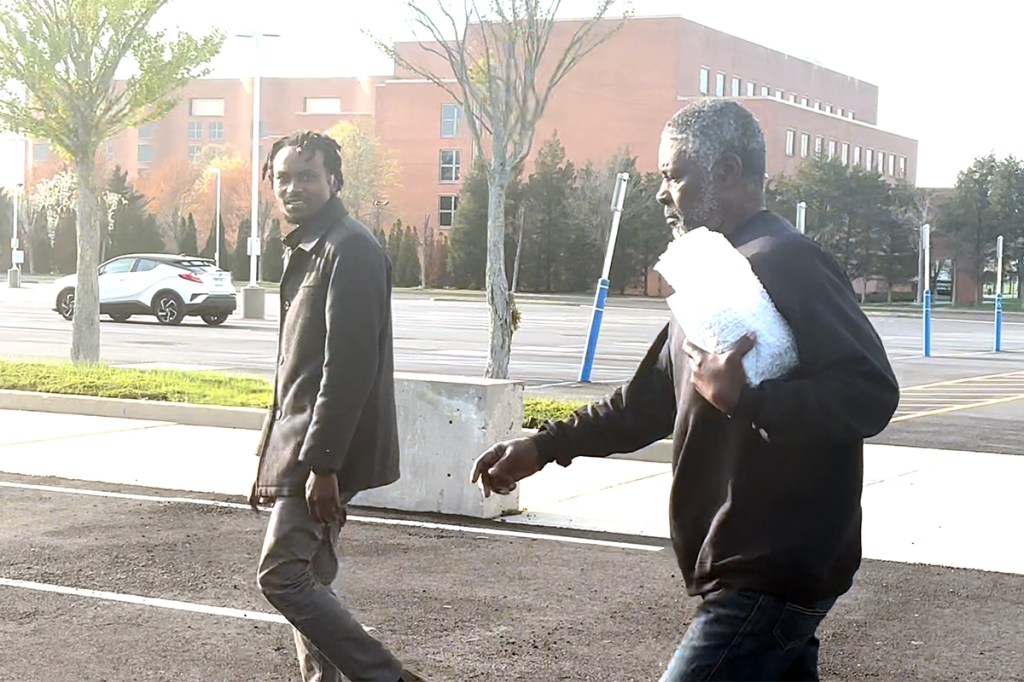Hampton Creatures: Peep, Honk, Woof, Hiss, Quack, Moo, Screech, Tweet

There’s been a lot of news in recent days about the creatures who live amongst us here in the Hamptons. As you know, humans are constantly trying to regulate or meddle with them, feed them, protect them, train them, kill them, eat them, keep them from being nuisances. Whatever.
For example, this was supposed to be the year when those big flying bugs, the cicadas, made their noisy appearance in the Hamptons. They hatch only once every 17 years, so it’s quite a shock when they find themselves suddenly out and about. The noise they make is a huge racket, and they fly around this way and that in locust-like herds so large they blot out the sun. It can be quite scary. There’s also an unpleasant smell. On the other hand, because all this happens so infrequently, we’re told we should marvel at this wonder of nature. Cicadas don’t bite. And they don’t damage much of anything, except for branches on some trees where they lay their eggs. Appreciate it.
What happened? Out here in the Hamptons, nothing. No noise. No cicadas. Seventeen years ago, their moms and dads didn’t bury the eggs in the trees in the Hamptons. They buried them elsewhere. Why? The year would have been 1996? What did we do wrong?
Well, if you see a cicada, be nice to it. Pet it. Give it some food. It’s got to be thinking about burying the eggs again this year.
Who you are not supposed to be feeding food to—in Sag Harbor, anyway—are the ducks and geese. The Sag Harbor Village Board spent a half an hour last Tuesday discussing the ins and outs of this. There’s a law on the books currently that says do not feed the geese. But there’s no law saying do not feed the ducks. This needs to be corrected.
It’s hard to feed one and not the other, he continued, because they will squabble over it. In particular the geese have a nasty temper. If you deliberately feed ducks, they will nip at you. They are offended.
Sag Harbor has a very famous sign that simply requests people not to feed the geese and ducks. It is along the banks of Otter Pond.
PLEASE DO NOT FEED THE GEESE AND DUCKS it says. Then it goes on to say EXCESSIVE FEEDING OF HIGH ENERGY FOODS (BREAD, CEREAL, POPCORN) CAUSES WATER FOWL TO GROW UNTIL THEY ARE TOO FAT TO FLY.
The wording of this entire sign is shown in the image accompanying this article.
Most people heed this warning, because they can get a mental image of an extremely overweight goose flopping around forlornly, fearful of the otter, trying desperately to flee the way he used to.
But others, who lack this mental ability, just rip off the pieces of bread and toss them out anyway.
There was discussion about whether this sign should be changed to read VILLAGE LAW PROHIBITS… (blah blah blah), instead of just the polite request. That was taken note of.
Eventually, the Village voted and passed a new village ordinance that makes it a crime to feed not only the geese, which is as I said, on the books, but also the ducks and the swans.
In East Hampton Town Hall, meanwhile, there was a lot of talk about the results of a deer survey. The Town had hired Vision Air Research, based in Boise, Idaho, to do a fly-over survey to count the deer in town in March, when the leaves are all off the trees.
Vision Air does a very thorough job. They are highly respected for what they do. Their aircraft fly over with infrared cameras taking pictures. With infrared, creatures show up glowing brightly. Humans appear as bright dots if they are vertical, pencil shapes if lying down. The big creatures have to be, in the absence of elephants, lions or tigers in these parts, deer. They are seen standing around or loping to here or there. No doubt about them. The town contracted to pay Vision about $13,000 to do the survey.
The results of the survey, in a report, were presented to the Town of East Hampton last week, and the Supervisor and Board members were quite shocked by it. They expected to be told there were thousands and thousands of deer in town. In 1996, they had a deer survey done which said there were 3,293 deer. Since that time, sightings have gone up, collisions between cars and deer have risen from 25 in 2000 to 108 in 2011, the number of deer killed by hunters up from 70 to 525 during those years, and the deer have done a much better job eating everything in sight. The undergrowth of bushes and plants has declined—wildflowers are a victim, somebody said—and you can just see there are so many more deer.
Vision Air reported there were only 877 deer in town in March during their flyover.
“Shall we pay them?” one of the councilmen asked.
The numbers they expected were 5,000 or 10,000 deer in East Hampton. (Human population about 25,000.) They expected a huge number.
877?
Had the deer been warned and gone into hiding? Was the survey faulty? One councilman said he personally had seen 80 to 100 deer together in one part of town nearly all at the same time. In that small area, was he seeing 10% of the whole herd? Unlikely, he said. Supervisor Wilkinson said they should consider just “discarding” the report. It was the wrong answer. Councilwoman Quigley then said if you order up a scientific study, you don’t throw it out just because you don’t like the results.
“There’s something so fundamentally flawed with getting a scientific study and then throwing it out,” she said, according to The East Hampton Star, which covered the meeting. “Isn’t history replete with examples of people taking action foolishly?”
“Perhaps adding a zero to that number might be more of what we expected,” Terry O’Riordan of the East Hampton Sportsman’s Alliance said, referring to the number 877.
There was, however, an interesting point that those in attendance at this meeting overlooked. In the earlier survey in 2006, the number was determined by counting the numbers of deer seen from the roads and nearby populated areas and then assuming those numbers were the same everywhere else. Extrapolating from what they saw back then, they came up with a total deer count of the 3,293.
In this case, however, with the flyover, Vision Aviation not only counted every deer everywhere, they also presented a map to the town showing where every deer was during the flyover. And that map showed most of the deer congregating in the populated areas, not out in the woods where the earlier surveyors could not see them but expected them to be.
This suggests, of course, that the earlier count was wrong. The deer love being around the people, apparently, or around all the delicious landscaping and gardens the people plant. Nobody noticed this irregularity.
Maybe the current Town Board just didn’t want to confront this idea. The whole point of having the flyover was to show that the deer count was out of control and the town was so inundated with deer that a new plan should be developed to deal with an apparently more urgent situation.
Maybe this was the cart before the horse, anyway. Well, if it didn’t turn out as expected, I guess we just kiss $13,000 goodbye.
In other news, the number of piping plovers that had chosen to build nests on the Hamptons beaches in April was way down from what it had been the year before. We’ve all seen the fenced-in areas on the beaches to protect these nests. They often block access to the beach. We all know that the piping plovers are the poster children for the Save the Environment movement, even if it means we all have to move out of their way anytime one of them appears.
(You will pay a huge fine, even go to jail, if you tamper with a plover nest.)
In prior years, a drop-off in the plover nest count would be a cause for alarm, further proof that the plovers were sinking fast, were on their way to extinction, that something must be done. Which then was.
Now, with this drop-off, there’s just silence. It’s our dark little secret. Happily, the plovers are going somewhere else. So we can now go to our beaches. And, if we don’t make any big deal of this, we won’t have to lay off the many government workers who have been hired to monitor, care for, feed, keep people away and otherwise protect piping plovers. They can keep their jobs. And they can have downtime. More texting, coffee breaks, novel reading, napping etc. etc., until the truth catches up with everybody.
Finally, there’s the sad, sad story of the swans in Town Pond in East Hampton.
Two months ago, a mom and dad swan showed up at the pond, to glide through the pond one on each side of a little snow-white cygnet they were protecting. It was so cute. You couldn’t get near them. They’d make menacing motions at you. (They are mute swans.) Leave our baby alone.
In past years, pairs of swans have raised nests full of cygnets in the pond. Environmentalists observing this year’s phenomenon determined that the two grown swans had been raising their brood at nearby Hook Pond, had had a few die, and with their last baby had decided to leave the nest at Hook Pond every morning and walk the quarter mile to Town Pond to keep her safe there. Perhaps things would be better at Town Pond. At night, they’d walk home to the nest.
Then, last week, it was just the mom and the pop. Since then, they have continued to show up at Town Pond every morning, and there’s usually a space between them. They seem to be imagining their last cygnet still there. They continue protecting, continue to walk over from Hook and back every day to do so. Even after baby is gone. We are told that in Town Pond, during the day, a snapping turtle must have gotten in and under the cygnet and killed it. There are snapping turtles in the pond.
The swan’s brains are the size of marbles, yet they seem to be mourning their loss. All that is left is the empty nest at Hook. So sad.



